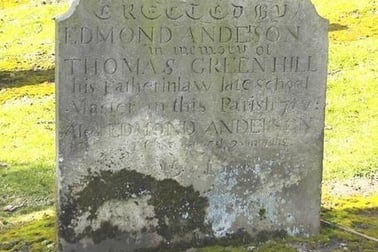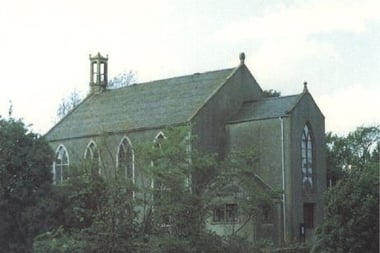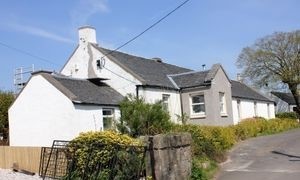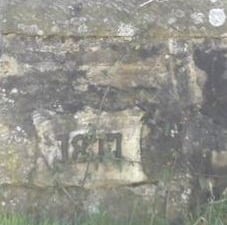MUIRAVONSIDE SCHOOL
Education has always been important to the people of the parish, and many children wound their way to the Kirk every morning after the formation of the parish in the late 1600s, and before that to Linlithgow or Falkirk or, if you could afford it, private tuition.
Children would enter the parish school at the age of 6 or 7. School was attended six days a week; the day was often long, sometimes beginning as early as 5 in the morning, although more often at 6, with one-hour breaks for breakfast and lunch. In the class the younger pupils would work alongside the older ones the alphabet would be learned through the Shorter Catechism and from 1616 all children had to learn the Catechism by heart. Reading progressed through the Proverbs to the Bible itself. The minister would examine the pupils' ability to read the Bible. Most children would not progress much beyond this stage of reading. However, some older pupils would advance to arithmetic and Latin and a few to writing. Many poorer families however could not afford the luxury of school, with some children never attending or only attending for two or three years as school was not compulsory. Several parish schools prepared their more able pupils for direct entrance to university. In the Lowlands of Scotland even this basic education meant that there was almost universal literacy. A practice common throughout Scotland at the beginning of the 19th century was the public examination of pupils held on the morning of the last day of the summer term.
A school serving the whole Parish of Muiravonside existed as early as 1723, somewhere near to the Parish Kirk. Parliament had decreed around 30 years before that “every parish not already equipped with a school was required to establish a schoolhouse and to provide for a schoolmaster”. There is in the Churchyard, a memorial stone to Thomas Greenhill who was the Schoolmaster of the Parish for much of that time. It is of course difficult to say just who attended the school as most of the children were at work especially in the mines where women and children were much preferred to adult males for much of the work.


A School in the village of Muiravonside opened around 1800, a stone built into the wall in front of the new school (presumably moved after the old school became a private residence) gives the date 1817, but many of the local children were still not getting an education as it wasn’t until 1848 that an Act of Parliament was passed prohibiting the employment of women and children underground (which wasn’t popular with the miners as this done away with a great amount of their income if you had a wife and five or six children working alongside you, someone else had to do the work and get paid for it ).
Monitorial systems developed at the end of the 18th century in response to a shortage of teachers and the increasing number of pupils in school classes. Someone from the older and more able children would undertake the role of monitor. These children would receive additional instruction from the schoolmaster and in turn they would instruct a group of children. An account of one school using this system described it thus “the desks were arranged around the walls of the schoolroom. The remainder of the space was empty except for the schoolmaster’s desk. One half of the scholars sat at the desks with their faces to the wall, employed in learning to write or cipher, while the other half stood on the floor, either reading or practising the rules of arithmetic. The classes on the floor were arranged in groups facing the schoolmaster with a monitor keeping order over each group. At the end of an hour those at the desks would change over with those on the floor. Writing would be carried out on slates, although the older children might use paper”.
Whilst monitorial systems overcame the teacher shortages and were inexpensive to run they had major drawbacks. They were regimented and involved rote learning and repetition. The mechanical routines of instruction also prevented an understanding of words and language.






Muiravonside School built 1817.
The increasing role of the government in teacher training is reflected in the Council of Education’s Minutes for 1846 introducing a national pupil-teacher scheme. Schools could select from their most promising thirteen-year-old students those most likely to be able to undertake an apprenticeship of up to five years duration. During the day they would follow the school’s curriculum and then receive additional instruction outside school hours on the art of teaching from staff appointed for this purpose. The most able students, selected through a competitive examination, were awarded a Queen’s Scholarship. Successful male students were awarded a grant of £25 and female students two-thirds of this. These grants supported their maintenance at the Normal School (the name given to the teacher training school). The school’s curriculum at this time was a broad one and included subjects such as drawing and music. At the end of their course the students would take an examination in both general and professional subjects conducted by Her Majesty’s Inspectors. The achievement of a Leaving Certificate carried with it an enhanced salary funded by the government.
Whilst not initially welcomed (‘it assumed a child could do two exacting things at once’), the pupil - teacher scheme, especially for elementary school teachers, was an improvement on the previous monitorial model, guaranteeing a minimum level of personal knowledge and achievement of recognised teaching skills. Certificated teachers were able to organise and teach the large number of children in sessional and subscription schools.
In 1858 the regular curriculum of the Normal Schools was extended to two years by regulation, with training ending in December instead of June. To qualify for their ‘parchment’ students, in addition to their Leaving Certificate, had to undertake a further two years of work teaching in a school. The final grade obtained depended on both their examination performance and the report of the HMI on their schoolwork. This new system of teacher training began to have a major effect on Scottish education. Newly qualified and certificated teachers were sought after and reasonably well paid. Their training gave them a wider knowledge than many parish schoolteachers previously and this in turn enabled them to teach a broader curriculum to children. The link with the churches was also lessening with increased government funding and the abolition of the need for teachers to sign the Confession of Faith.
The 1872 Education (Scotland) Act marked a watershed in Scottish education. For the first time elementary education was made compulsory for all children aged between 5 and 13.
The existing parish and burgh schools were taken over by the state and managed by locally elected School Boards (anyone was allowed to stand for election as long as they had property worth £4). The new system was co-ordinated nationally by the Scotch [sic] Education Department with the curriculum emphasising the teaching of reading, writing, and arithmetic (the three ‘R’s’). The churches made a crucial contribution to the new system by handing over their schools without charge to the School Boards.
The first Muiravonside School Board members were, in 1873.
John Logan, Coalmaster Candy
David Rodger, Bookkeeper Falkirk
Andrew Reid, Farmer Haining Valley
George Gray Esq., Proprietor Windyyett
Thomas Livingstone - Learmonth, Proprietor Parkhall
Rev. George Keith, Minister Muiravonside Manse
William Orr, Farmer Boxton
M.T. Hamilton, Land Stewart Callander
J.G. Urquart, Proprietor Vellore
A. S. Aisling, Proprietor Muiravonside House
The schools in the Parish were.
Muiravonside School, in the village of Muiravonside with accommodation for 55 children but had 57 at this time.
Drumbowie School, in the village of Standburn.
A subscription school at Avonbridge with accommodation for 62 but had 70 at this time, only a very small part of Avonbridge is in the parish and only a few children from the parish attended the school there.
A school in Maddiston which was situated down the close right in the centre of the village (variously mentioned as Maddiston School, Maddiston Classroom, Maddiston Schoolroom or Maddiston Infant School) with accommodation for 32 but had 70 at this time.
A shared interest in the school at Brightons (a Free Church School, which was just passing into the control of Polmont Parish School Board), 94 children from Muiravonside Parish were in attendance there.
A school at Linlithgow Bridge.
A school for Roman Catholic children in St Anthony’s Chapel in Rumford.
10 children were being educated privately and 40 children were not attending school between the ages of 5 and 13 (some of those were in employment at “public works”). The Board reckoned there was upwards of 600 children in the Parish of school age in 1873, this is nearly double what the estimate was only two years before. Muiravonside Parish School Board could provide education for 352 children (allowing eight square feet of flooring for each child).
Education in Muiravonside Parish
This section is still being compiled so more to be added later.
Muiravonside Church